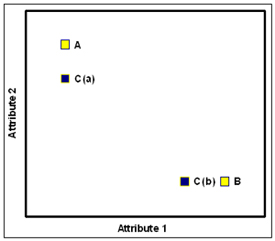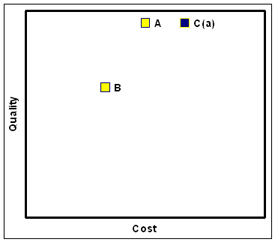Asymmetric dominance and trade proposals
Imagine that you own Kevin Youkilis. You’re a Yankees fan and you hate the Red Sox, so you want to get rid of him out of spite. So you toss him up on the trading block and list outfielders and starting pitchers as your needs. The next morning, one manager offers you one of the following players for Youkilis:
1) Matt Kemp
2) Roy Halladay
Which offer are you more inclined to accept?
It turns out that you’re not sure which you one you want, so you let the trade offers linger for a couple days until the other owner cancels them. A week later, you find that that manager has now offered you a choice of three players for Youk:
1) Matt Kemp
2) Roy Halladay
3) Alex Rios
Now which offer are you more inclined to accept? Did your answer change at all?
The point I am trying to illustrate is one that was raised by one of our readers, Ben, here in the comments section of my previous article. That idea is the asymmetrical dominance effect , also known as the decoy effect.
The asymmetrical dominance effect is the phenomenon in which people show a change in preference between two items when a third item, dominated by either of the first two items, is introduced as an option. There are multiple research studies in which this effect is manifested, and I’ll describe two of them, beginning with the one mentioned in the comments section of the article linked above.
The first study is one that was conducted by Dan Ariely, and in this experiment, students at the University of North Carolina and Duke University were presented with prospective dating partners and instructed to pick a single person to ask out on a date. Three different types of situations were presented:
1). Situation 1 consisted of dating options A and B, both of whom were attractive but had varying degrees of attractive characteristics.
2). Situation 2 consisted of dating options A, B and C(a), with C(a) being almost but not quite as appealing as A.
3). Situation 3 consisted of dating options A, B and C(b), with C(b) being almost but not quite as appealing as B.
So a graphical illustration might look something like this:

The results of this experiment helped support the asymmetrical dominance effect. Participants were more likely to select dating option A over dating option B when the third dating option, C(a), who was slightly less appealing then A, was present. And conversely, participants were more likely to choose dating option B over dating option A when the third dating option, C(b), who was slightly less appealing than B, was present.
The effect manifests in situations outside of partner selection as well. The second study I want to describe is another study by Ariely. This time, subjects were divided into two groups. In group one, subjects decided between microwaves A and B, with microwave A being expensive and of high quality, and with microwave B being less expensive and of medium quality. Forty percent of the subjects in group one preferred microwave A and 60 percent preferred microwave B.
Subjects in group two had three microwaves to choose from: microwaves A and B, and then a third microwave, C(a), that was very similar in dimensions and quality to microwave A, but was more expensive. So in this scenario, it was very clear that microwave C(a) was dominated by microwave A.
A graphical illustration of this paradigm presented to group 2 might look something like this:

While the majority of subjects in group one preferred microwave B to microwave A, the subjects in group two showed a different preference. This time, 56 percent of subjects chose microwave A, 36 percent chose microwave B and the remaining 8 percent chose microwave C(a). Somehow, this introduction of the third microwave, C(a), completely reversed the ratio of preference between microwaves A and B:
Microwaves A B C(a)
Group 1 40% 60% --
Group 2 56% 36% 8%
Despite differing situations (people/dates vs. microwaves), the underlying theme in both of these studies is the same. That is, that the presence of a third option, one that has an asymmetric dominance relation with one of the two other alternatives, affects a person’s preference of a given alternative over a second alternative.
Let’s go back to my scenario at the top of the page. The construct, according to the studies mentioned earlier, would be as follows:
1) Player A
2) Player B: similar to A but has different attributes
3) Player C(a): dominated by A, meaning he has similar attributes but is slightly less appealing
Using Chone projections for 2009, and using the average draft positions (ADP) as sort of an anchoring point for market value, we’ll have this:
ADP Runs HR RBI BA SB W K ERA WHIP Matt Kemp 38 84 16 74 0.311 26 Roy Halladay 46 -- -- -- -- -- 13 152 3.56 1.22 Alex Rios 39 86 17 75 0.285 19
In looking at these stat lines, I think it’s pretty clearly that Alex Rios serves as Matt Kemp’s decoy. They both have similar attributes (R, HR, RBI), but Rios is slightly less appealing (lower BA and less SB). In other words, Rios is dominated by Kemp and would most likely never be chosen in this scenario given these numbers.
As Ben asked a couple weeks ago, the question then, is can this actually be applied to fantasy baseball?
My answer is yes, I do think that the asymmetric dominance effect can manifest itself within the realms of fantasy baseball. If we look at Ariely’s study, each potential dating option had varying degrees of attractive characteristics; some were funnier than others, some more intelligent, others a little more honest, and so on. Each option had different levels of attractive attributes that made it more (or less) appealing than the other options. We do the same thing with baseball players but instead of judging them by cost and quality like we did with the microwaves, we look at runs, home runs, batting average, etc.
Considering that these items are essentially the same, presenting our trade proposals in a similar format as with the dating options and microwaves should have some sort of effect since, what really matters, is the contextual configuration of the options. This doesn’t mean these types of trade proposals will always work, as there are many variables to consider. And, after all, the opposing manager can still decline all three proposals whereas the subjects in these studies were forced to pick. However, it does seem as if designing trade proposals in this way would have an effect in that it may increase the likelihood that a trade will happen in the first place or that the third, lesser player will really serve as a decoy.

You could use this idea when making trade offers to try to influence which player you want the other manager to prefer.
In you example, Rios makes Kemp look better, so you might offer Rios to try to influence the manager to take Kemp instead of Halladay. Of course, you could always not offer Halladay, but if you really wanted Youkilis, maybe you’d accept moving Halladay but prefer to move Kemp.
Great article, I second what Ed said.
Hi Marco,
Yeah, that’s exactly what I was talking about. I’m a librarian, not a behavioral economist; I read Ariely’s book, which was geared toward a lay audience. So I didn’t retain (read?) the specific terminology—my apologies on that front.
Anyway, yes, Ed—that’s exactly what I was wondering: could you use that effect to subtly direct your trade partner to choose one offer over another? I’ve tried it a few times with no luck, but sample sizes being what they are…
Thanks,
Ben
I can’t remember a specific instance of it working, but I know I still try it, so it hasn’t backfired at least
Could this also work the other way in a trade deal? Meaning you have a player you know another team wants. In return, you give them three options. 2 quality players, but the third is similar to but considered more valuable than the one you want or expect in return.
Youk’s owner shouldn’t even think about it in the first place, fan or no fan.
Can the theory of relativity also be applied to fantasy trades?
An interesting piece, although it’s not clear that Asymmetric Dominance really has any role to play in trading in Fantasy Baseball. The reason that it exerts an influence in every day choice is because it is so hard to value different attributes. However, this is not the case with most trades (or players). We have rankings, projections, dollar values, SGPs… all of which should make people less prone to Asymmetric Dominance (or Compromise Effects, etc) than for other choices… now there’s an undergraduate dissertation for someone to consider.
It should be noted as well that most theorists believe that Asymmetric Dominance is a cognitive shortcut which helps us to simplify choices, whereas fantasy players may be less motivated to use simplifying strategies (unless there was time pressure, for example). After all, we do seem to quite like numbers!
Again, guys, thanks for reading and leaving comments. And again, I apologize for my delay in response—I have to admit that my level of productivity, in life, decreases significantly during March Madness, especially when my alma mater made the tournament for the first time since 1998!
I think Ed has the right idea, in that we are trying to *influence* judgment and decision-making. In my example, by including Rios in our set of trade offers, we are trying to persuade the other owner to accept Kemp instead of Halladay. If we were intent on giving up Halladay instead of a hitter, we might include someone like Cliff Lee alongside Kemp and Halladay.
And John, I think an issue with the asymmetric dominance effect and other biases (and this applies to any field, not just fantasy baseball) is that the degree of effect these biases have are sort of tied to the level of expertise and amount of knowledge.
In other words, I can see something like this working to a higher degree in average public or private leagues, where the level of knowledge might still be stuck on superficial stats. For example, just look at ESPN’s fantasy section. They just recently began referencing BABIP, whereas BABIP has been common knowledge for a while now here at THT.
But would something like this work in a league full of Derek Carty’s and Paul Singman’s? Probably not. Now this doesn’t mean that cognitive biases or effects don’t exist at ‘expert’ levels; everyone is prone to some form of bias. I think the likelihood of bias just decreases.
When the asymmetrically dominated option is present,a higher percentage of consumers will prefer the dominating option than when the asymmetrically dominated option is absent..
get out of the friend zone